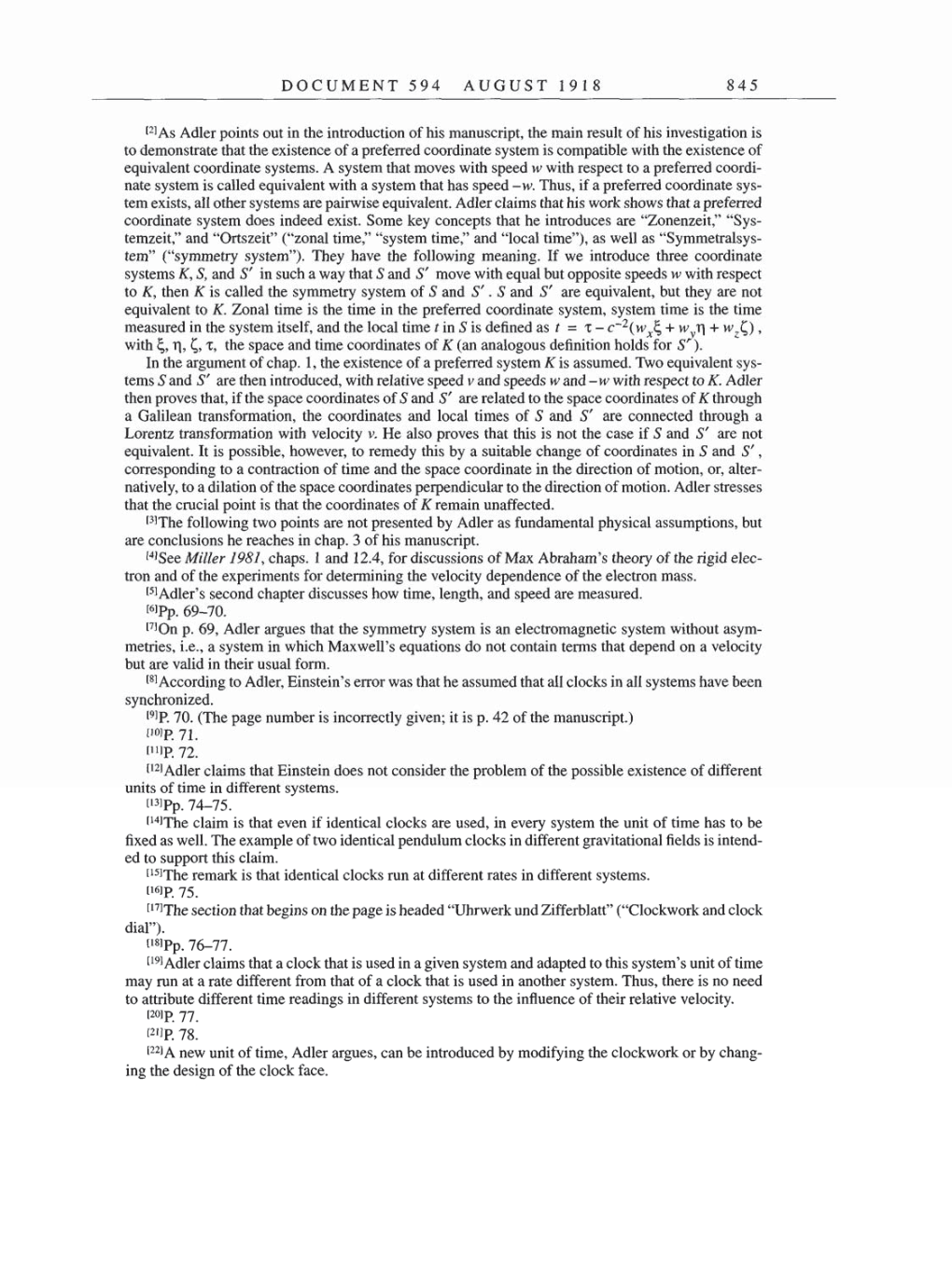DOCUMENT 594 AUGUST 1918 845
[2]As
Adler points
out
in the introduction
of
his
manuscript,
the main result
of
his
investigation
is
to
demonstrate that the existence
of
a
preferred
coordinate
system
is
compatible
with the existence
of
equivalent
coordinate
systems.
A
system
that
moves
with
speed
w
with
respect
to
a preferred
coordi-
nate
system
is called
equivalent
with
a system
that has
speed
-w.
Thus,
if
a preferred
coordinate
sys-
tem
exists,
all other
systems are
pairwise
equivalent.
Adler
claims that
his work shows that
a preferred
coordinate
system
does indeed exist. Some
key concepts
that he introduces
are
"Zonenzeit,"
"Sys-
temzeit," and
"Ortszeit"
("zonal
time," "system time," and "local
time"),
as
well
as
"Symmetralsys-
tem" ("symmetry
system").
They
have
the
following
meaning.
If
we
introduce three coordinate
systems
K, S,
and
S'
in such
a way
that
S
and
S'
move
with
equal
but
opposite speeds
w
with
respect
to
K,
then K is called the
symmetry
system
of
S and
S'.
S and
S'
are equivalent,
but
they are
not
equivalent
to
K.
Zonal time is the time in the
preferred
coordinate
system, system
time is the time
measured in the
system
itself,
and the local time
t
in S is defined
as
t
=
x
-
c-2(wxE
+
wyn
+ wzQ),
with
q,
n,
Ç,
x,
the
space
and time coordinates
of
K
(an
analogous
definition holds for
S').
In the
argument
of
chap. 1,
the existence
of
a preferred system
K is assumed. Two
equivalent sys-
tems
S
and
S'
are
then
introduced,
with relative
speed v
and
speeds w
and
-w
with
respect
to
K.
Adler
then
proves
that,
if
the
space
coordinates
of
S
and
S'
are
related
to
the
space
coordinates
of
K
through
a
Galilean
transformation,
the coordinates and local times
of
S
and
S'
are
connected
through a
Lorentz
transformation with
velocity v.
He also
proves
that this is
not
the
case
if
S and
S'
are
not
equivalent.
It is
possible,
however, to
remedy
this
by a
suitable
change
of
coordinates in
S
and
S',
corresponding
to
a
contraction of time and the
space
coordinate in
the direction
of
motion,
or,
alter-
natively,
to
a
dilation
of
the
space
coordinates perpendicular
to
the direction
of
motion. Adler stresses
that the crucial
point
is
that the
coordinates
of
K
remain unaffected.
[3]The following
two
points
are
not
presented
by
Adler
as
fundamental
physical assumptions,
but
are
conclusions he reaches in
chap.
3
of
his
manuscript.
[4]See
Miller
1981,
chaps.
1
and
12.4,
for
discussions
of
Max Abraham’s
theory
of
the
rigid
elec-
tron and
of
the
experiments
for
determining
the
velocity dependence
of
the electron
mass.
[5]Adler’s
second
chapter
discusses how
time,
length,
and
speed
are
measured.
[6]Pp.
69-70.
[7]On
p.
69,
Adler
argues
that the
symmetry
system
is
an electromagnetic system
without
asym-
metries, i.e.,
a system
in which Maxwell’s
equations
do
not
contain
terms
that
depend on a velocity
but
are
valid in
their
usual form.
[8]According
to Adler,
Einstein’s
error was
that he assumed that all clocks in all
systems
have been
synchronized.
[9]P.
70.
(The
page
number
is
incorrectly given;
it is
p.
42
of
the
manuscript.)
[10]p.
71.
[11]p.
72.
[12]Adler claims that
Einstein
does not consider the
problem
of
the
possible
existence
of
different
units
of
time in different
systems.
[13]Pp.
74-75.
[14]The
claim is that
even
if
identical clocks
are
used,
in
every system
the unit
of
time has to be
fixed
as
well. The
example
of
two
identical
pendulum
clocks in different
gravitational
fields is intend-
ed
to
support
this claim.
[15]The
remark
is that
identical
clocks
run
at
different
rates
in different
systems.
[16]P.
75.
[17]The section
that
begins on
the
page
is headed
"Uhrwerk
und Zifferblatt"
("Clockwork
and clock
dial").
[18]Pp.
76-77.
[19]Adler
claims that
a
clock
that is used
in
a given system
and
adapted
to
this
system’s
unit
of
time
may run
at
a
rate different
from
that
of
a
clock that
is
used
in another
system.
Thus,
there is
no
need
to attribute different time
readings
in different
systems to
the influence
of
their relative
velocity.
[20]P.
77.
[21]P.
78.
[22]A new
unit
of
time,
Adler
argues, can
be introduced
by modifying
the clockwork
or by chang-
ing
the
design
of
the clock face.
